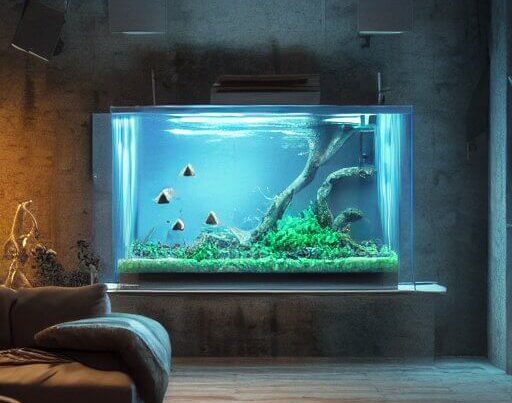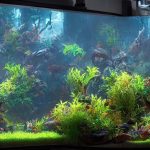Aquariums often bring a sense of calm and relaxation to many homes. Watching fish darting around, swimming gracefully in their underwater world can be quite mesmerizing. While feeding our aquarium fish is important for ensuring their health and survival, it is equally important to understand how long they can go without a meal. With that in mind, this article will explore the fascinating topic of how long aquarium fish can go without food and discuss the factors that impact their hunger levels.

Food & Aquarium Fish
Food & Aquarium Fish is an important topic for all fish tank owners to consider. Having a well-fed fish is key to keeping your aquarium healthy and vibrant. With so many different types of food available, it can be difficult to choose the right one for your particular species. It can also be hard to determine how long aquarium fish can go without food, especially if they are new to the tank.
The truth is that all fish need a regular diet in order to stay healthy, and even more so when they are living in an enclosed environment such as an aquarium. The amount of time a fish can go without food depends on the type of species, its age, and size, as well as any other dietary needs it may have.
Fish Digestion
Fish digestion is a fascinating process that helps keep aquarium fish healthy and happy. Knowing how long aquarium fish can go without food is an important part of understanding their digestive systems. If you’re wondering about the answer to this question, read on to learn more about how long your fish can go without eating.
The digestive process for most aquarium fish begins as soon as they take in food. Food is usually broken down by the stomach and intestines, providing essential nutrients for them to survive. Depending on the species and size of the fish, some require more frequent meals than others. A general rule of thumb is that smaller species may need to eat every day while larger species may only need one or two feedings per week.
Impact of Missing Meals
Missing meals can have a significant impact on aquarium fish, but the extent of that impact depends largely on the type of fish. The most common issue associated with going one or two meals without food is a decrease in energy levels and vitality. Fish that are accustomed to being fed twice daily may appear lethargic and sluggish if they miss a meal. This is especially true for species like cichlids, which are known to be very active and require frequent feedings.
Additionally, missing meals can lead to nutritional deficiencies, resulting in poor growth and weakened immune systems, making them more vulnerable to diseases and parasites. Furthermore, prolonged periods of starvation can cause serious and irreversible health issues such as organ failure or even death in some cases. It’s important for fish owners to create an optimal feeding schedule based on their particular species’ needs so that their aquatic pets never go too long without eating.
Benefits of Fasting
Fasting can be a great tool for aquarium fish owners, allowing them to maintain the health of their tank while giving their fish a break from regular feeding. Fasting can help reduce the amount of waste in the water and also gives the fish an opportunity to purge any internal parasites that may be present. Not only does it keep your tank clean and healthy, but fasting has many benefits for fish too.
When done correctly, fasting can improve digestion for your aquarium friends. This is because when food is not readily available, the body will burn stored fat reserves instead. Additionally, by taking regular breaks from eating, your fish can rest their digestive systems which help to prevent diseases from developing over time due to excessive strain on their bodies. Furthermore, intermittent fasting encourages better nutrient absorption as there are fewer competing molecules present in the gut during this time period.
Types of Fasting
Fasting is an increasingly popular method of improving individuals’ overall health and well-being. Throughout history, different types of fasting have been used for a variety of reasons, including spiritual rituals, health regimens, and weight loss. There are many different ways to fast, each with its own set of benefits and drawbacks. Here’s a quick overview of the three main categories of fasting: intermittent fasting, alternate-day fasting, and extended fasting.
Intermittent fasting involves alternating periods of eating and not eating throughout the day or week. This type is one form that can be easily incorporated into an everyday routine since it does not require people to completely eliminate food from their diet for extended periods of time. Intermittent fasting has been linked to improved blood sugar levels as well as improved mental clarity and focus due to its ability to regulate insulin levels in the body.
Different Types of Aquarium Fish
When it comes to owning aquarium fish, there are a variety of species available. Different types of aquarium fish require different levels of care and attention, including feeding schedules. Before selecting any type of aquarium fish, it is essential to understand the needs of the specific species. When considering how long aquarium fish can go without food, many factors must be taken into accounts such as size and breed.
There are common freshwater species that make great additions to home aquaria, such as guppies, tetras, goldfish, mollies, and angelfish. Saltwater varieties include clownfish, damselfish, and wrasses among others. These fish have varying lifespans and appetite levels; some may need to be fed daily while others may only need to be fed once or twice a week.
Hunger Strike Prevention of Aquarium Fish
Aquarium fish require a balanced diet to remain healthy and happy. Unfortunately, despite the efforts of aquarium owners, hunger strikes are all too common in these aquatic ecosystems. While it is possible for some species to survive without food for a few weeks or longer, it is important to understand the risks associated with withholding nutrition from aquarium fish.
Aquarium fish owners have a responsibility to ensure the health and safety of their pets. One way to prevent hunger strikes in aquarium fish is to provide them with the proper nutrition. A well-balanced diet is essential for a healthy, stress-free fish life. One important factor in preventing hunger strikes among aquarium fish is feeding them properly.
When providing food, it’s important that enough food be given at once rather than multiple times per day; this makes it easier for the fish to digest their meal and prevents overeating. It’s also important that only the most appropriate type of food be used; some types of food may not be suited for all kinds of aquarium fish, so research should be done beforehand on what kind of food works best for each species.
In general, most species of aquarium fish need to be fed at least once a day in order to meet their nutritional needs.
Conclusion
Now we have a better understanding of how long aquarium fish can go without food. The answer depends on several factors, including species and age, water temperature, health status, and other environmental conditions. In general, it is safe to say that all aquarium fish should be fed at least once or twice a week with a nutritious diet that meets their needs.
It’s important to remember that some fish may require more frequent feedings than others. For instance, younger fish tend to need more nutrients due to their rapid growth rates. Additionally, during times of stress or illness, it is best to provide small meals multiple times per day until they are healthy again. By understanding your fish’s dietary requirements and providing them with the right foods in the right amounts you can ensure they stay healthy and vibrant for years to come!




